I've assigned each coordinate to a cluster using k_means clustering and am hoping to show the density of each cluster with plotly go.Densitymapbox.
import plotly.graph_objects as go
colors=[(0.0,'#170d33' ), (0.058, '#170d33'),
(0.058, '#2f4b7c'),(0.116,'#2f4b7c'),
(0.116,'#2f4b7c'),(0.174,'#2f4b7c'),
(0.174,'#665191'),(0.233,'#665191'),
(0.233,'#875296'),(0.291,'#875296'),
(0.291,'#a05195'),(0.348,'#a05195'),
(0.358,'#d45087'),(0.40,'#d45087'),
(0.40,'#f95d6a'),(0.465,'#f95d6a'),
(0.465,'#ff7c43'),(0.523,'#ff7c43'),
(0.523,'#ffa600'),(0.581,'#ffa600'),
(0.581,'#ffc332'),(0.638,'#ffc332'),
(0.638,'#fff629'),(0.69,'#fff629'),
(0.69,'#f7ffbd'),(0.754,'#f7ffbd'),
(0.754,'#d2ffbd'),(0.81,'#d2ffbd'),
(0.81,'#a2ffc9'),(0.86,'#a2ffc9'),
(0.86,'#85ffd4'),(0.924,'#85ffd4'),
(0.924,'#1cfff0'),(1.0,'#1cfff0')]
fig=go.Figure(go.Densitymapbox(lat=data['lat'], lon=data['lng'], z=data["cluster"], coloraxis='coloraxis'))
fig.update_layout(height=800, width=1000, coloraxis=dict(colorscale=colors), mapbox_style="open-street-map",
mapbox_layers = [
{
"sourcetype": "image",
"source": img,
"coordinates": bbox_coords
}], font=dict(size=24), font_family='Open Sans')
fig.show()
Implementing the discrete color scale produces the following:

While the default colorscale produces this:

It's just difficult to make out the clusters with the default colorscale but I've found almost nothing in the documentation on specifying a discrete colorscale with the density plot, which makes me think it's not really done? I would appreciate any alternative solutions to plotting this that I may be overlooking!
Data can be found below:
{'lat': {0: 43.6,
1: 45.33,
2: 32.38,
3: 34.0,
4: 30.31,
5: 37.64,
6: 34.43,
7: 31.39,
8: 33.34,
9: 40.138306,
10: 40.68,
11: 34.28,
12: 35.862833,
13: 35.28,
14: 32.75,
15: 29.62,
16: 29.757561,
17: 35.07,
18: 45.51,
19: 27.190719,
20: 37.51,
21: 40.41,
22: 36.81,
23: 36.81,
24: 26.2},
'lng': {0: -96.59,
1: -122.57,
2: -94.87,
3: -84.62,
4: -97.94,
5: -122.11,
6: -119.72,
7: -97.21,
8: -86.78,
9: -88.161651,
10: -111.82,
11: -119.29,
12: -94.196334,
13: -120.66,
14: -117.21,
15: -82.38,
16: -95.36525,
17: -82.37,
18: -122.61,
19: -80.236942,
20: -77.69,
21: -105.01,
22: -119.87,
23: -119.87,
24: -80.15},
'price': {0: 37000.0,
1: 99000.0,
2: 65000.0,
3: 27800.0,
4: 52500.0,
5: 27000.0,
6: 72000.0,
7: 25000.0,
8: 69000.0,
9: 34500.0,
10: 55000.0,
11: 89000.0,
12: 92000.0,
13: 72000.0,
14: 24000.0,
15: 55000.0,
16: 37500.0,
17: 44000.0,
18: 32500.0,
19: 39000.0,
20: 39900.0,
21: 48500.0,
22: 59500.0,
23: 96500.0,
24: 45500.0},
'cluster': {0: 14,
1: 3,
2: 1,
3: 4,
4: 1,
5: 11,
6: 2,
7: 0,
8: 8,
9: 9,
10: 11,
11: 2,
12: 2,
13: 7,
14: 5,
15: 1,
16: 1,
17: 8,
18: 15,
19: 0,
20: 8,
21: 10,
22: 7,
23: 3,
24: 0},
'centroids': {0: 0,
1: 0,
2: 0,
3: 0,
4: 0,
5: 0,
6: 0,
7: 0,
8: 0,
9: 0,
10: 1,
11: 0,
12: 0,
13: 0,
14: 0,
15: 0,
16: 0,
17: 0,
18: 0,
19: 0,
20: 0,
21: 0,
22: 0,
23: 0,
24: 0}}